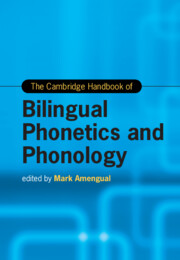Book contents
- The Cambridge Handbook of Bilingual Phonetics and Phonology
- Cambridge Handbooks in Language and Linguistics
- The Cambridge Handbook of Bilingual Phonetics and Phonology
- Copyright page
- Dedication
- Contents
- Figures
- Tables
- Contributors
- Acknowledgments
- Introduction Bilingual Phonetics and Phonology
- Part I Approaches to Bilingual Phonetics and Phonology
- 1 Generative Approaches to Bilingual Phonetics and Phonology
- 2 Usage-Based Approaches to Bilingual Phonetics and Phonology
- 3 Sociolinguistic Approaches to Bilingual Phonetics and Phonology
- 4 Psycholinguistic Approaches to Bilingual Phonetics and Phonology
- 5 Neurolinguistic Approaches to Bilingual Phonetics and Phonology
- 6 Computational Approaches to Bilingual Phonetics and Phonology
- Part II Theoretical Models of Bilingual Phonetics and Phonology
- Part III The Phonetics and Phonology of the Bilingual Child
- Part IV The Phonetics and Phonology of the Bilingual Adult
- Part V The Diversity of Bilingual Speakers
- Part VI Variables and Outcomes of Bilingual Speech
- Index
- References
4 - Psycholinguistic Approaches to Bilingual Phonetics and Phonology
from Part I - Approaches to Bilingual Phonetics and Phonology
Published online by Cambridge University Press: 14 November 2024
- The Cambridge Handbook of Bilingual Phonetics and Phonology
- Cambridge Handbooks in Language and Linguistics
- The Cambridge Handbook of Bilingual Phonetics and Phonology
- Copyright page
- Dedication
- Contents
- Figures
- Tables
- Contributors
- Acknowledgments
- Introduction Bilingual Phonetics and Phonology
- Part I Approaches to Bilingual Phonetics and Phonology
- 1 Generative Approaches to Bilingual Phonetics and Phonology
- 2 Usage-Based Approaches to Bilingual Phonetics and Phonology
- 3 Sociolinguistic Approaches to Bilingual Phonetics and Phonology
- 4 Psycholinguistic Approaches to Bilingual Phonetics and Phonology
- 5 Neurolinguistic Approaches to Bilingual Phonetics and Phonology
- 6 Computational Approaches to Bilingual Phonetics and Phonology
- Part II Theoretical Models of Bilingual Phonetics and Phonology
- Part III The Phonetics and Phonology of the Bilingual Child
- Part IV The Phonetics and Phonology of the Bilingual Adult
- Part V The Diversity of Bilingual Speakers
- Part VI Variables and Outcomes of Bilingual Speech
- Index
- References
Summary
Psycholinguistic theories conceptualize the mind as a set of mechanical processes that map between levels of mental representation. Cognition is seen as a form of computation, emerging from the interaction of these processes. We explore how this conceptualization frames psycholinguistic research questions. We first examine how the idea of “mind as computer” leads psycholinguists to examine two broad types of questions. Some studies focus on the structure of mental representations (e.g., are “similar” speech sounds associated with one vs. two representations across languages?). Others focus on the number and nature of processes underlying behavior (e.g., to what extent do speech perception and speech production rely on distinct vs. shared processes?). We then turn to connectionism, a specific computational framework that has dominated psycholinguistic theories of bilingualism. Connectionism’s conceptualization of processing as spreading activation has driven studies of representation and processing. We conclude by considering how psycholinguistic theories can inform as well as be informed by other perspectives
Keywords
- Type
- Chapter
- Information
- The Cambridge Handbook of Bilingual Phonetics and Phonology , pp. 86 - 103Publisher: Cambridge University PressPrint publication year: 2024

